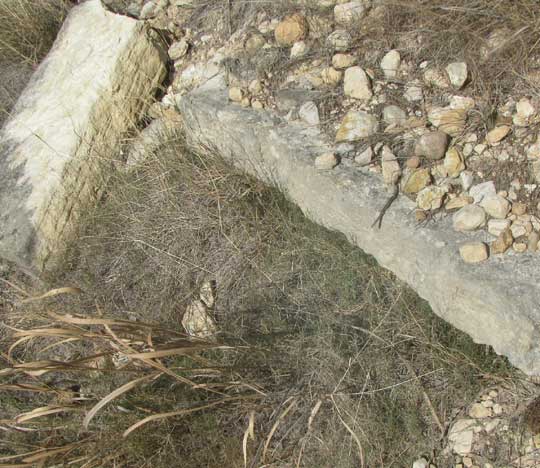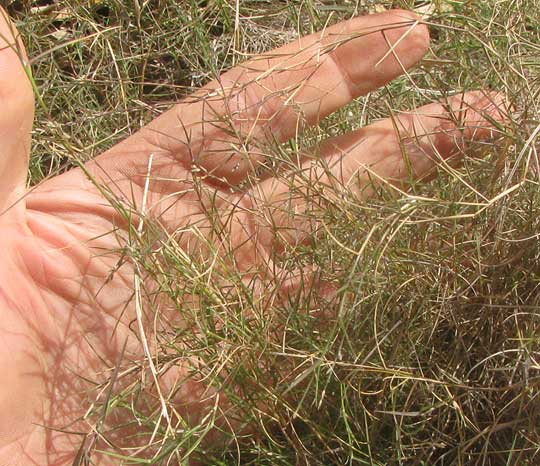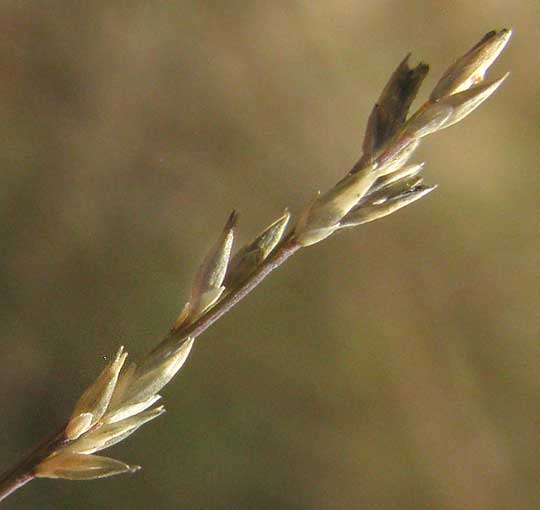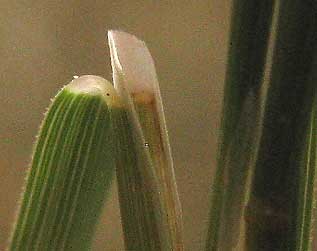Excerpts from Jim Conrad's
Naturalist Newsletter
from the January 12, 2014 Newsletter issued from the Frio Canyon Nature Education Center in the valley of the Dry Frio River in northern Uvalde County, southwestern Texas, on the southern border of the Edwards Plateau; elevation ~1750m (~5750 ft); N29.62°, W99.86°; USA
APAREJOGRASS
Scouring the landscape for organisms overlooked during the warm months, something really new looking turned up at the Dry Frio River's water edge. It was a foot-high tangle of grass looking like dried-out straw tightly stuffed beneath a layer of limestone jutting from the bank's wall. That's it below:

Notice how small this grass is compared to the brown-leafed Switchgrass occupying the picture's lower, left corner. The smaller grass's threadlike leaves, mostly about ¾-inch long (18mm), are shown below with my hand behind them for scale:

Within the tangle a few flowering heads were to be found. One with its spikelets not quite 2mm long (1/16th inch) and arrayed in a narrow panicle is shown below:

 And the grass's ligules -- earlike appendages that may or may not arise at the base of a grass's leaf where it meets the stem -- is well formed and distinct, as shown at the right.
And the grass's ligules -- earlike appendages that may or may not arise at the base of a grass's leaf where it meets the stem -- is well formed and distinct, as shown at the right.
With all its parts being so small, the spikelets' glumes and lemmas being so distinct, with its well developed ligule, and its unusual growing habit, this grass keyed out relatively easily. It's Aparejograss, MUHLENBERGIA UTILIS, both names suggesting that in the past the grass was regarded as useful.
The word "apareo" appeared in the US Spanish-speaking Southwest back in the 1800s, when it was applied to a kind of packsaddle constructed with stuffed leather cushions. A packsaddle is a saddle-like structure secured on the back of a horse, mule or other working animal so it can carry heavy loads such as baggage and firewood. Therefore, it seems that back when horses and mules carried loads on their backs, Aparejograss was the grass of choice for stuffing packsaddle cushions. Even the "utilis" in the binomial says how "useful" the grass was when it was named. My impression is that larger, coarser grass species when dried out tend to crumble, but masses of tiny grass like Aparejograss don't.
Aparejograss is distributed from the US Southwest through Mexico and as far south as Costa Rica. It grows in wet habitats, especially riverbanks and meadows. The grass in our pictures grows so near the Dry Frio's water that it must be submerged occasionally throughout the year after heavy rains.